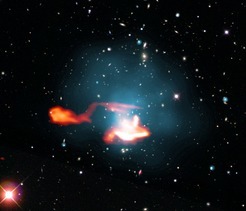In observations of galaxy clusters, astronomers in collaboration with the MPA discovered a new class of cosmic radio sources. With the digital radio telescope Low Frequency Array (LOFAR) they received the longest radio waves that can be measured on Earth. They identified a remarkable "tail"behind a galaxy in the radio light, which must have been re-energized after it had faded away. In the journal Science Advances, the team describes this discovery, which either confirms a theoretical prediction on the interaction between shock waves and radio plasma or represents a novel phenomenon.

Fig.False colour image of the galaxy cluster Abell 1033, consisting of a superposition of images in the radio, X-ray and optical frequency range. The radio galaxy with its tail appears as an orange, luminous, outward-directed structure in the left part of the picture. Its tail extends to the right into the upper part of the centre of the cluster of galaxies; as the gas emits X-rays there, it is shown here in blue. This tail was made to shine again by processes in the cluster of galaxies. The bright source in the lower part of the cluster is presumably independent and has also been classified as a re-iluminated radio tail of another galaxy, i. e. another "radio phoenix".
Looking into space with the help of radio telescopes, astronomers often find long, radio-luminescent tails behind wandering galaxies. These tails occur when the active black hole in the center of a galaxy produces clouds of energetic electrons with typical velocities close to the speed of light. These clouds then stay behind the galaxy, which is traveling through the gas filling the intergalactic space.
Normally, these luminous trails fade over time until they are not visible anymore, as the electrons radiate their energy away. However, a group of researchers from Germany, Italy, the Netherlands and the United States observed the galaxy cluster Abell 1033 at very low radio frequencies and found that one of the tails was behaving contrary to expectations, starting to glow again in the galaxy gas (see figure).
This is surprising as the electron clouds that make up the tail gradually release their energy. They should therefore fade until they finally disappear completely. Instead, in this case, the observed tail still shines after more than a hundred million years - and what is more, it is located in the middle of a cluster in which several galaxies are merging.
